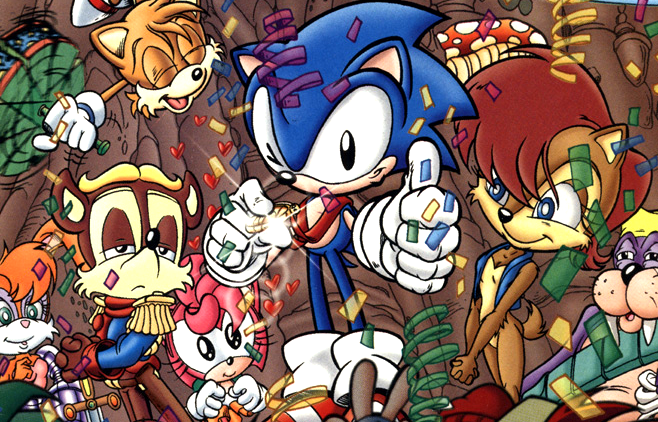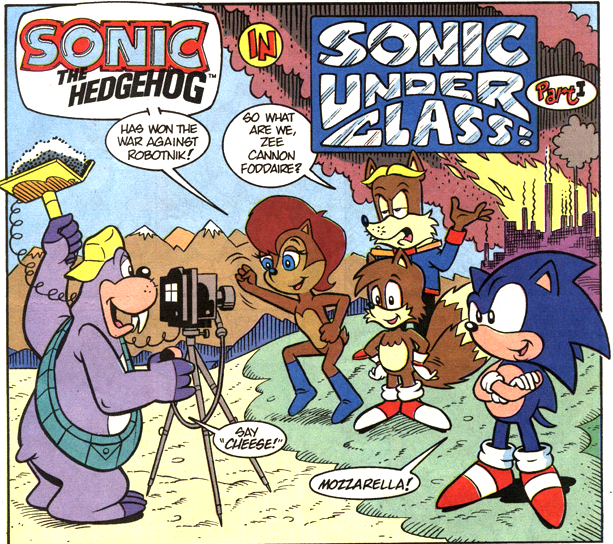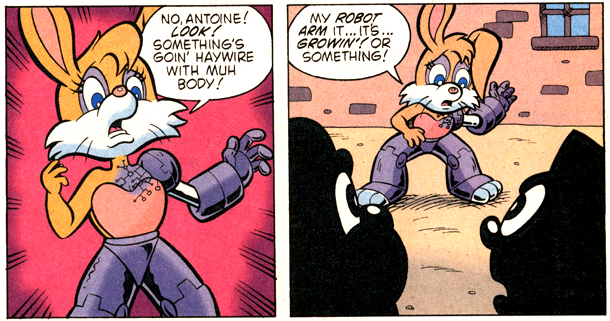10 weird and wonderful Archie Sonic stories that hold up today

(EDIT 9/25/2024: This piece is now mirrored on my new personal blog! I’m no longer using Medium, and can’t guarantee that this site won’t mess with my formatting or randomly lose chunks of the article, as it’s done in the past.)
In my recent retrospective on Ken Penders’ run on Archie’s Sonic the Hedgehog and its spinoffs, I was very negative, because reading his comics is often a nightmare. But Ken wasn’t the only writer, and focusing exclusively on him doesn’t paint a full picture of the series.
In this shorter followup, I’d like to highlight ten stories that stood out to me in the much-maligned first thirteen years of the series. Most readers will tell you to skip to Sonic #160, when the reigns were handed to the ever-popular creative duo of Ian Flynn and Tracy Yardley (who are still doing phenomenal Sonic work at IDW today). But thanks to stories like these, I’m glad I gave the earlier issues a fair shake.
1. Mecha Madness
Sonic #39 and Sonic & Knuckles: Mecha Madness Special. Writer: Michael Gallagher, Penciler: Pat Spaziante

If there’s one story arc everyone remembers as being cool as hell from early Archie Sonic, it’s “Mecha Madness.”
The story goes like this: A couple issues prior, the Freedom Fighters had invented a gizmo that could allow a Mobian to retain their free will when roboticized. Thus, Sonic had an idea: why not stick one of these gadgets on his person, let Robotnik turn him into a robot, and then use his new super-strong robot powers to finally beat Robotnik once and for all?
This plan gets shot down for being too dangerous. But then Sonic gets captured and roboticized anyway, and all hell breaks loose. What proceeds is basically an excuse for beloved cover artist Pat Spaziante to draw cool robot fights, with many one-liners of varying quality along the way.

This one isn’t gonna win any awards for its writing. It’s loud and stupid. But it’s exactly what most kids in the ’90s wanted out of a Sonic comic.
Of course, the flashy action of “Mecha Madness” isn’t particularly representative of the earliest comics. Let’s look at a more typical example.
2. Sonic’s Christmas Carol
Sonic #6. Writer: Angelo DeCesare, Penciler: Dave Manak

Yes, this is literally just an adaptation of A Christmas Carol with Sonic characters.
I know that including this nonsense has ruined the credibility of this list, and I don’t care. The sheer absurdity of this one has always made it stand out to me as a highlight of the comic’s earliest days. It’s deeply silly and it knows it. I can’t not love it.

It also gave me one of my favorite out-of-context Sonic panels of all time.

3. Sonic Under Glass
Sonic #16. Writer: Ken Penders, Penciler: Dave Manak

Yes, even Ken had a couple stories I liked. His early work from before he started indulging in his worst tendencies hold up pretty decently, to be honest. One of my favorite stories of his is a rather unassuming one in a random early issue. In it, we open with the revelation that the Freedom Fighters have apparently beaten Robotnik off-screen. Peace has been restored to Mobius. Sonic and Sally are even getting married.
Then, of course, comes the twist: none of this is real. Robotnik has captured the Freedom Fighters. However, he decided that simply roboticizing them or killing them wouldn’t be satisfying enough after their years of meddling with his schemes. So instead, he hooks them up to a virtual reality simulation where all their dreams come true. On top of getting the satisfaction of knowing that their happiness is based on a big fat lie, he’ll now be free to go on a global rampage and the Freedom Fighters will be none the wiser.

In earlier issues, Robotnik was a joke. He once literally screwed up building a robot so badly that he somehow accidentally created a robotic version of Steve Urkel. (Yes, the irony of Jaleel White’s other most famous character appearing alongside Sonic is not lost on me.) While this is still a very silly story, the diabolical nature of this scheme has always made it stand out to me.
4. Bunnie’s Worst Nightmare
Sonic #37. Writer and penciler: Rich Koslowski

In my Penders piece, I mentioned that my favorite character in the series was Bunnie Rabbot. There are many reasons for this, from her upbeat attitude, to her ability to kick robot ass, to the fact that cyborgs are just plain cool. But this story from when the comics were slowly starting to get serious really solidified her as my favorite.
In it, Bunnie realizes that her roboticized parts are slowly starting to take over the rest of her body. Robotnik is finally finishing what he started, and the super-strong robot parts that allow Bunnie to protect her friends are now making her a threat to them. Distraught, Bunnie decides to leave Knothole so that she won’t hurt anyone. Even with the simple, kid-friendly framing of this story, it’s pretty tragic.

And then… Bunnie wakes up. It was all a bad dream. (Maybe the title should’ve clued my stupid ass in.) In many cases, this would feel like a cop out. But here, I’d argue that framing it as a dream makes it more interesting. Now, this nightmare is framed not as a random bad thing that happens one day, but as something Bunnie apparently worries about all the time. The ending makes it clear that this nightmare scenario is gonna be in the back of her mind for a long time. And yet, in spite of this, Bunnie still puts on a brave face every day for the sake of her friends, being one of the most upbeat and positive members of the team.

Honestly, if there’s one element I wish the early comics explored more, it’s the cyberpunk-y transhumanist-y themes inherent to the whole roboticization thing. And really, Bunnie was the perfect character to explore these themes with, as a character who’s half organic and half roboticized. (Because of this, in my extremely biased opinion, I honestly think Bunnie could’ve made a better lead protagonist for this incarnation of the series than Sonic himself.) Between both the early Archie comics and SatAM, both of which criminally underutilized Bunnie, this story stands out as an instance where her potential finally started to come to the surface, if only for a few pages.
5. Icon
Sonic #62-#63. Writer: Karl Bollers, Penciler: Steven Butler
I feel sorry for Karl Bollers. While he wrote his fair share of stories I didn’t care for, he also wrote a lot of my favorites (as the rest of this list goes to show). But he’s almost as widely disliked as Penders in the fandom. This is primarily due to the messy romantic drama he wrote. But to be fair, the dreadful Mina Mongoose love triangle was mandated by editor Justin Gabrie. And I‘d argue “the Slap” only became infamous because he quit before he could resolve the tension between Sonic and Sally, leaving them in a worse place than when he started.
Bollers really is a talented guy, though! And his earliest stories as the new lead writer on the main series proved it. They were consistently fun and adventurous, they played around with Sonic’s super speed, and when paired with artist Steven Butler, his stories tended to make creative use of comics as a medium.

One such story was at the very start of his tenure as lead writer — “Icon.” This was part of what’s been dubbed the “World Tour” arc, in which Sonic and Tails left Knothole for nearly a year of comics in search of one of the major villains. One of the most memorable stops along their globetrotting adventure was in Sand-Blast City, a very Mad Max inspired safe haven in a robot-infested desert. The problem? Since he’s the guy who defeated Robotnik, the Sand-Blasters worship Sonic as their hero, the greatest Freedom Fighter of all time, and their new personal savior… and they won’t let him leave.
The Sand-Blasters wait on Sonic hand and foot, but when he and Tails try to leave, they aren’t afraid to use force. Ultimately, in order to escape and get back to his important mission to find Ixis Naugus, Sonic destroys their force field (and, in a very symbolic gesture, their statue of him) and leaves the fanatical Sand-Blasters to fend for themselves against the robot horde. It was probably the right call, but it was a surprisingly dark note to end the story on. Sonic would regret his actions here for many issues to come. One story even showed that he had recurring nightmares about it.
While this story is going on, Bollers also keeps cutting over to parallel events happening closer to Knothole. See, Robotnik’s cowardly nephew Snively has been in jail since shortly after Robotnik’s defeat in issue #50, along with a bunch of the miscellaneous C-list villains — most of whom are incredibly jacked furry dudes. When the locks on their cells are mysteriously opened by a shadowy figure, Snively gets all the credit, and they immediately make him their new leader. All the while, Snively is terrified. But he pretends to be their new fearless leader anyway, knowing that it’s probably his one ticket out.
Here’s the kicker that allows this parallel between Sonic and Snively to make sense: back in issue #50, when Robotnik was defeated? Sonic wasn’t actually the one who did Robotnik in. He was there when it happened, sure, but Robotnik was killed by his own Ultimate Annihilator. But everyone, including the Sand-Blasters, gives him the credit for it. Not unlike how Snively takes credit for the jailbreak. But while Snively gets a happy ending in this story, Sonic’s is more bittersweet.

In a series where the morality is normally so black and white, it’s interesting to see a story end on a dark note like this, with Sonic being forced to do something cruel that he would regret for many issues to come. He couldn’t stay in Sand-Blast city, of course, and later stories would reveal that they survived (although they’re not exactly fans of Sonic anymore), so it’s not like he killed them. But to see direct parallels drawn between the main hero and the most cowardly villain in a series like this is kind of fascinating.
6. The Sonic Adventure 2 tie-in
Sonic #98. Writer: Karl Bollers, Penciler: Pat Spaziante
This is a pretty straightforward story that basically just summarizes the premise of Sonic Adventure 2, and then tells you to go buy the game. Archie had to do this occasionally, with mixed results.
I love this one for one reason: we got to see Pat Spaziante draw City Escape.


7. Reunion
Sonic #100. Writer: Karl Bollers, Penciler: Ron Lim
This one’s a bit harder to appreciate unless you’re familiar with the overarching story of Archie Sonic and know where the story was at around issue #100. But when I was neck deep in the series, this felt like a breath of fresh air. After so many stories from multiple different writers in which Sally felt like a supporting character who never got to do anything, Bollers let her do something cool. Something VERY cool. He gave her a magic sword and had her restore the free will of the Robians.

Hell yeah!! Not even Ron Lim’s wonky Sonic art can ruin this one for me.
Actually, as an aside, this almost played into a really cool subplot that sadly never made it into the series. If you’ve read my blog or the Penders retrospective, you may remember me discussing “the Sally Dip Story,” in which Sally nearly bonded with the omniscient “Source of All” that her family worships. Well, the Sword of Acorns that Sally uses in this story is made of Source goop, and it starts talking to her (and through her). See, Bollers actually knew how absurdly creepy the Source concept was, and wanted to run with that. He planned on revealing that the Source wasn’t a benevolent deity, but more of an eldritch one that wanted to corrupt Sally’s family.
It’s too bad he never got to do this. But he did at least blow up the Source of All. So there’s that.
8. Sonic Adventure 2.5
Sonic #124-#125. Writer: Karl Bollers, Pencilers: Dave Manak, Art Mawhinney, Ron Lim, Dawn Best, Stephen Butler, J. Axer
This was my favorite arc in the comics as a child, and I was pleasantly surprised to see that it’s still a fun read today.
This arc marked the 10th anniversary of the series, and was also the climax of the first ten years of comics. It was a big deal. And what did Bollers do with this momentus issue?
He had an alien menace show up on Mobius to reveal a long-foreshadowed truth: that Mobius is a post-apocalyptic Earth.

Yes, this cartoon wonderland full of different fantasy and sci-fi elements is actually a post-apocalyptic Earth in the distant future. Humanity has been nearly wiped out, and colorful creatures of all kinds now roam the lands. In other words: Archie Sonic did Adventure Time’s big twist years earlier.
Bollers had been foreshadowing this twist since basically day one of his run, and it always seemed like he had a lot of fun with it. From the aforementioned Mad Max-themed story, to mentions of an apocalyptic “Day of Fury” in the distant past, to Station Square being a giant underground human city built to ride out the apocalypse, to “Old Megaopolis” very clearly being the ruins of New York, the writing had been on the wall for ages.

This is the kind of weird that I love in the Archie comics. Not Penders’ hangups with gender roles and dads. Not the agonizing love triangles. Just some good clean fun with a story about how all the furries in Sonic are actually post-apocalyptic mutants.
Anyway, so once these aliens figure out that they didn’t successfully wipe out all life on Earth, they come back to finish the job. And so in Sonic #125, just about every character in the series teams up to stop them.

They make a valiant effort (and there’s also a cool part where Sonic and Sally pilot a mech built by Eggman), but this isn’t enough. In the end, only Sonic is fast enough to stop the doomsday device. After a tearful goodbye with Sally, he sacrifices his own life to save the planet.

Yes, this is all melodramatic. But if you’re not reading these comics for the juicy melodrama, then I don’t know what to tell you.
Of course, Sonic isn’t really dead. They still did like 170 more issues after this. But he WAS transported to the other side of the galaxy when he destroyed the doomsday device. This lead directly into the “Tossed in Space” arc, which was also pretty fun!
9. Return to Angel Island
Sonic #138-#141. Writer: Karl Bollers, Penciler: Jon Gray

I already gushed about this arc in the Penders retrospective, so I’ll try to avoid repeating myself too much. But this truly is a wonderful story arc, one that brought out the potential I always knew Archie Sonic had.
In this arc, the conflict on Angel Island is completely reinvented, with Eggman’s forces having taken over and Knuckles and the other echidnas now being the underdogs. Every single character involved feels more interesting and believable than they ever did in Ken’s comics. The focus isn’t on Knuckles’ racist grandpas and how cool Ken thinks they are, but rather on everyone else. It manages to tell a more satisfying arc in four issues than Penders was able to tell over the course of a decade.
With the change in writers, Knuckles’ world also suddenly has way more elements from the games. This includes big changes, like most of the locations visited being taken directly from Sonic 3 & Knuckles (Marble Garden, Lava Reef, Hidden Palace), as well as more subtle touches, like Knuckles compensating for his current lack of superpowers with his upgrades from Sonic Adventure 2.
On top of all this, it also introduces a new echidna character: the Dark Legion scientist Dr. Finitevus. While just about every panel with the guy radiates evil energy, he also feels like he believes what he’s doing is right — something that Ken’s Knuckles comics always struggled with. The other echidnas have turned to spirituality, relying on their faith in the prophecy surrounding Knuckles, even when the Legion is right there with the resources to solve their problems with science. Yeah, the Legion has ulterior motives, and they want control over Angel Island for their own purposes, but they really are trying to help everyone. It’s understandable that Finitevus would be pissed about the way everyone worships Knuckles.

This was the only arc Bollers got to write with Dr. Finitevus before he left, but Ian Flynn would do a lot with the character in the following years, firmly cementing him as a fan favorite.
In a way, this whole arc feels like a meta commentary on Ken’s work. The echidnas literally worship Knuckles as their savior because a prophecy told them to, even when he has no powers. He’s not sure if the prophecy is true, or if he can even do anything to help. But ultimately, it’s not his dad or the prophecy or any of that that allows Knuckles to win. It’s the fact that he never gives up, even when the odds are stacked against him. Here he comes, rougher than the rest of them.The best of them. Tougher than leather. You can call him Knuckles
While the arc is pretty serious, it also has many genuinely funny moments, thanks in part to the outstandingly energetic art by Jon Gray. I already shared this part in the Penders article, but I’d be remiss to leave out the introductory scene for Knuckles’ baby brother:

And the other best part about this arc? In the climax, when Knuckles transforms into his super form? Jon did a shot for shot recreation of Elpizo’s final boss transformation from Mega Man Zero 2.
Honestly, if there’s one story arc you should track down and read from the first 13 years of Archie Sonic, it’s absolutely this. This was the last Arc of this scope that Bollers wrote for the series before his departure, but man, did he go out with a bang.
10. Stargazing
Sonic #151. Writer and penciler: Tania del Rio
Let’s end on a high note with hands down my favorite backup story: “Stargazing,” written and drawn by Tania del Rio of Sabrina the Teenage Witch fame. This is an immensely important little story for Archie Sonic. In it, Sally is awoken one night by a strange figure seen leaving her bedroom. When she follows it outside, she finds something she didn’t expect: her AI assistant Nicole has given herself a simulated organic form.

In a series that’s normally very bombastic and absurd, this is a very gentle, emotional story. Nicole is just happy to be experiencing life as an organic being, if only for a brief moment. While she’d been in the comics for over a decade, it feels like Sally and Nicole are only truly meeting for the first time here. The shoujo manga look is a departure from the usual designs, but del Rio’s expressions really sell the subtle emotions of this scene.


Despite Sally’s protests, Nicole can’t stay in this form forever. It takes a lot of power to maintain a solid hologram like this, and her data is much easier to hack in this form.
The two decide to simply watch the stars together as Nicole fades away and returns to her computer form.

As I said, this short story was hugely influential. It introduced Nicole’s holo-lynx form, which reinvented the character and allowed her to become a major player in the Archieverse. (Going back to the Adventure Time comparisons, I’d compare Nicole’s arc to how BMO went from being Finn and Jake’s talking Game Boy to being one of the most beloved main characters.)
The other obvious impact of this story was that folks started shipping Sally and Nicole. A lot. I mean, it’s no wonder why. Whether or not the romantic subtext was intentional, it’s there. I’d almost say these two have a more sincere emotional connection in this scene than Sonic and Sally ever did. It’s a quiet, tender moment that makes me feel things.
The pairing would become so popular that, actually, after the 2013 reboot? Ian Flynn and co. would start sneaking in hints that Sally and Nicole actually were in love. Discussing their relationship, he once said “I would dare say that if you go through the book since the reboot, you could probably make a case for it.” And after the Archie comics were suddenly canceled and they no longer had corporate breathing down their necks, the creative team came forward and said that yes, Sally and Nicole were a couple.
Sallicole for life babey
And so, those are a few of my favorite Archie Sonic stories from before the Ian Flynn era. This isn’t every story I like from back then, of course. There were a handful of other Bollers stories I considered including, and a Robin Hood inspired arc from Penders ended up being much more entertaining than I expected. There’s also Joe Edkin’s early issues on Sonic X, which are extremely entertaining and criminally underrated.
If you found this more positive look at the comics entertaining, be sure to check out my blog Thanks Ken Penders later this month! I’ll finally be starting the Ian Flynn era, which I’m very excited about. I hope to see you then!
